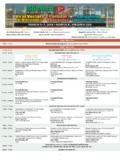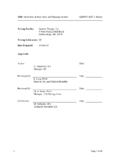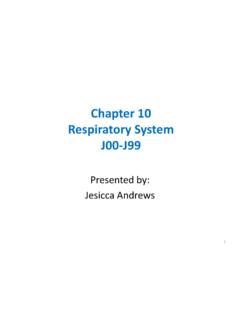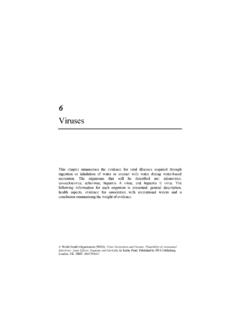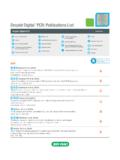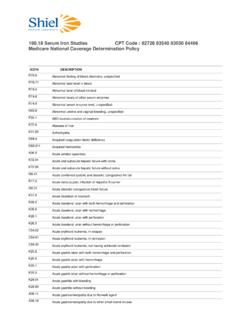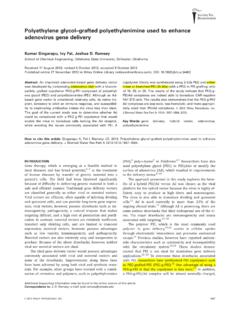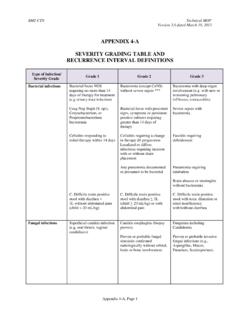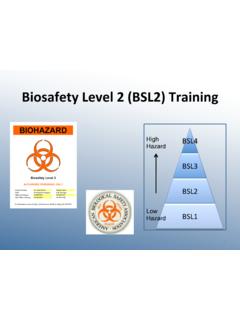Transcription of SOP for Analysis of Particle Size Distribution of ...
1 Croyle Particle Sizing Protocol 1 SOP for Analysis of Particle size Distribution of Recombinant adenoviral Preparations Purpose: To outline a method for measuring the average Particle radius of purified recombinant viral preparations. This method can be used to detect aggregate formation in preparations containing adenovirus concentrations between 1 1010 to 5 1012 particles /ml. Scope: The method described measures the average hemodynamic radius of an adenoviral preparation by dynamic light scattering. The degree of aggregation formation in a preparation can be assessed by the degree of deviation from the average radius of a single adenoviral Particle (70 + 15 nm). Background: particles move through solutions at a certain rate of speed. Larger particles tend to move at a much slower rate than smaller particles and they also tend to displace light to a greater degree. The medium in which the particles are suspended can also influence the rate of motion ( if a medium is rather viscous, movement will be impaired ) and should always be considered in data Analysis .
2 This technique consists of exposing an adenoviral sample to a laser light beam. Deflections in the beam are recorded over time and the average dynamic radius of particles suspended in a preparation calculated using the Stokes-Einstein equation. Advanced software can divide the data into specific subpopulations and quantitate the proportion of the viral preparation that has a certain hydrodynamic radius. This technique is routinely employed in our laboratory to assess aggregation phenomenon of adenoviral vectors under different stress conditions. A manuscript describing this work is in preparation. Cheng, X. and Croyle, M. (2001) Formulation factors that prevent viral aggregation and subsequent loss of infectivity after several freeze-thaw cycles. Pharm. Res. (in preparation). Materials: a) Water, ultrapure (MilliQ water or sterile distilled water) b) Viral formulation without virus (Ad5 WT Reference Material Excipient prepared as per SOP outlined in RPF ) c) Polystyrene beads with radius of 35 + nm (Protein Solutions cat# 003295 or equivalent) d) Sterile microliter pipette tips with aerosol filters for 1-200 l volumes.
3 E) Ad 5 WT Reference Material f) Sterile microcentrifuge tubes, ml. g) Bleach 5% h) Cuvette cleaning solution 2% DNA Away (2 ml DNA Away in 98 ml MilliQ water) i) Methanol, HPLC grade j) Source of compressed air k) Biohazard bags and containers for liquid waste and pipette tips. Croyle Particle Sizing Protocol 2 Equipment a) Biosafety cabinet suitable for BL-2 containment. b) Adjustable microliter pipettes 20-200 l c) Laser light scattering device and detection system (Dyna Pro LSR Microsampler, Protein Solutions) d) Quartz cuvette, 1 cm path length, with a minimum volume of 12 l fitted with an appropriate sealing cap. e) Vacuum cuvette washer or equivalent f) Data Analysis software (DynaLS or Dynamics software, Protein Solutions) Method 1. Turn on Dyna Pro LSR and detection system. Let device warm up for no less than 30 minutes prior to Particle size Analysis . 2. Check to make sure the instrument is working properly: a)Clean cuvette by: 1) rinsing with cuvette cleaning solution 2) flooding cuvette with MilliQ water until foaming stops 3) rinsing once with methanol 4) dry cuvette under vacuum 5) purge with air from compressed air source to remove dust particles .
4 B)Add to cuvette 45 l of a standard solution of polystyrene beads with an average radius of 35 + nm. Add preparation slowly to the cuvette with the pipette tip placed close against the bottom of the cuvette to prevent bubble formation Seal cuvette with cap. c) Place cuvette in light scattering device. d) Start count rate mode to pre-screen the sample for a period of one minute. If count rate does not fluctuate beyond 15% of the mean, begin Particle size measurement under a setting that takes a reading every 10 seconds for one minute. If the count rate demonstrates severe fluctuations beyond 15% of the mean, remove the sample by vacuum, clean cuvette as described in step 2A and add a fresh aliquot of polystyrene bead standards. e) If the measurement falls within the range + 2 nm of the recommended size on the label, proceed to step 3.
5 If the measurement falls outside of these specifications, repeat steps 2a-2c. Save data and print a hard copy of the regularization histogram and corresponding data. Croyle Particle Sizing Protocol 3 3. Remove the polystyrene standard solution by vacuum and clean cuvette as described in step 2A. 4. Slowly add to cuvette 45 l of the Ad5 WT Reference Material Excipient with the pipette tip placed close against the bottom of the cuvette to prevent bubble formation. Seal cuvette with cap. 5. Place cuvette in light scattering device. 6. Start count rate mode to pre-screen sample for a period of 1 minute. You should receive an error message stating that no counts can be detected. If this happens, proceed to step 7. If you get a count rate and it is in the acceptable range, measure the Particle size the conditions described in step 2D. If the size is above nm, remove the solution from the cuvette by vacuum, clean the cuvette and purge with compressed air as described in step 2A and re-screen count-rate until it falls within the acceptable range.
6 7. In a sterile 500 l centrifuge tube, place 22 l Ad5 WT Reference Material Excipient. 8. Add 22 l Ad5 WT Reference Material (thawed at room temperature in a biological safety cabinet) to the same tube and mix well by gently pipetting the mixture up and down slowly several times. 9. Slowly add this mixture to cuvette with the pipette tip placed close against the bottom of the cuvette to prevent bubble formation. Seal cuvette with cap. 10. Place cuvette in light scattering device. 11. Start count rate mode to pre-screen the sample for a period of one minute. If count rate does not fluctuate beyond 15% of the mean, begin Particle size measurement under the conditions described in step 2D. If the count rate demonstrates severe fluctuations beyond 15% of the mean, remove the sample, clean cuvette as described in step 2A and add a fresh aliquot of reference material/excipient as prepared in steps 7 and 8.
7 12. Save data on hard drive in the appropriate project folder, back up on Zip disk and print three hard copies. 13. After sample Analysis , clean the cuvette thoroughly with : a) 5% bleach solution b) cuvette cleaning solution c) ultra-pure water d) methanol 14. Dry cuvette thoroughly prior to storage. Croyle Particle Sizing Protocol 4 15. Turn off the DynaPro LSR and the computer. Review/Reporting Data 1. Once the Particle size measurement is complete, scan the cumulants data log. If a data point possesses an SOS error > 5, remove it from the Analysis . If more than 3 points are rejected from a single Analysis , the measurement must be taken with fresh sample. 2. If data points must be eliminated, re-analyze data with DynaLS software. 3. Once data has been qualified, the regularization histograms and data log are printed and placed in appropriate project folder and saved in the appropriate hard drive of the computer system.
8 4. Data is reported as radius (nm) + standard deviation with the percent of the entire preparation that falls into this category. Sample data 35 + nm 123 + 12 nm 546 + 22 nm
